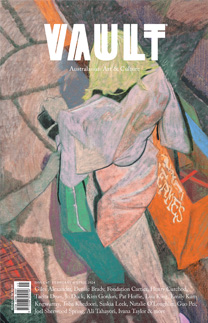The Next
Generation
of Art Dealers
Against the ever-changing backdrop of the art market, new gallerists have emerged, bringing fresh faces and fresh ideas that are re-invigorating and challenging the once familiar gallery visiting experience. VAULT asked the following gallerists questions about their ongoing belief in the gallery system and how they perceive the future.
Hugo Michell Gallery
In my opinion the gallery system is still hugely important in today's art world. I am all for art fairs and the Internet but for me they are certainly not the be all and end all. I don't believe that we would have the relationships we do with our clients, institutions and our artists without physically having a gallery space. Having a gallery space means artists and/or curators can better control the environment of the space they are exhibiting in and create a conversation between works that would probably not occur online.
We have two spaces in our gallery, our main space where we predominantly show our represented artists and the project space. The project space gives us the opportunity to exhibit emerging and often unrepresented artists. Without this space we would never be able to give these exciting artists the exposure they need.
Art fairs and the Internet have been great for us in terms of broadening our client base (both locally and interstate, even internationally) but predominantly these people are already established collectors who are familiar with the commercial art world. We have a number of clients, who are new to collecting, that perhaps do not have the confidence to buy online and prefer to see the work in person. This can be a great opportunity for us to advise and assist in building a client's collection.
Robert Heald
The gallery space enables something essential to artists and viewers alike – an ongoing and intimate acquaintance with an artist's work opposed to more isolated and fleeting encounters.
Utopian Slumps
Over the last decade there have been some shifts in Melbourne's gallery scene. Independent spaces have professionalised, and commercial galleries have risen from ARI origins. Geoff Newton's Neon Parc is an example of this, Newton having started with Dudespace in his home in Brunswick. Utopian Slumps is another example, having started as a non-profit in Collingwood. Now there is some new young blood in the commercial sphere; KalimanRawlins, Sarah Scout, Daine Singer, Neon Parc, Utopian Slumps, Blockprojects and Murray White Room, to name a few. As the Founder and Director of Utopian Slumps I feel that each of these galleries has carved a unique path through the way that they operate and the artists they work with, paths that will hold us in good stead for the future.
Ryan Renshaw Gallery
In an age where we are consuming more and more art virtually I do recognise the pragmatic decision for galleries to abandon bricks and mortar in favour of international art fairs and pop-up projects. This idea is particularly potent when you consider that, as an art dealer, you know that the overwhelming majority of visitors to your gallery space do so ‘to look' and not necessarily to purchase. And yet paradoxically it is this idea of a commercial gallery providing a vital (and free) social and cultural service to the community that makes me more committed to maintaining a physical space. It's fair to say that historically, commercial galleries have been at least as instrumental in setting contemporary aesthetic agendas as larger public institutions, and retaining physical gallery spaces are crucial in this on-going development of contemporary art.
Murray White Room
The critical role played by good commercial galleries is the ongoing representation of new work by living artists and the opportunity it provides artists to create new work for committed exhibitions on a regular basis. This commitment to new work on the primary market provides artists an income they would otherwise not receive on the secondary market. Sometimes commercial galleries are underestimated for this role, and perceived as glorified shops in the hierarchy of exhibition venues… I mean... museums sell tickets and merchandise like there's no tomorrow for God's sake.
Currently there is some debate regarding the practicality of maintaining a physical gallery in the digital age. It has been suggested that the way of the future is to close the gallery, maintain a high online presence, and travel the international art fair circuit.
After recently attending the inaugural Art Basel Hong Kong art fair, it is difficult to understand how this proposed model could be sustainable. Our recent financial investment in attending Art Basel Hong Kong – for just 5 days – equates to well in excess of a full year's rent in the Melbourne gallery. While this model is clearly viable for established galleries, it is always a potential risk for younger galleries who represent less expensive work by emerging and mid-career artists.
Current visitor numbers to the actual gallery are certainly down – in part due to the Internet – however to cease exhibiting contemporary art in the gallery eliminates ‘exhibition', i.e. the historical display context for art in both visual and educational terms.
KalimanRawlins
The gallery space is not dead because the Internet is not alive. The gallery is a social space for the artists; the social Internet can't provide the same kind of socialising because that's about personality building and illusions. The illusions one finds at a gallery are different, and they include the illusion of the artwork.
The system of artist representation and collecting is built on trust. A gallery space provides a form of trust that the Internet and ‘pop-ups' will never be able to achieve. You may now do all your banking online, but you only do so with the knowledge that the ‘actual' bank is located somewhere that you can visit, that's why you're not buying art with Bitcoins. So, the gallery space is not dead because of two things – trust and social interaction.
BlockProjects
To me, art galleries are one of the only commercial places on earth in which we feel content to be by ourselves. It is by being alone with the art hanging on the walls of a gallery that we can begin to understand how we relate to art and what the artist is trying to convey. In this day and age this contemplation is rapidly becoming a unique experience.
Dianne Tanzer Gallery
Galleries are not just four walls to hang art on. They are a hub for collaboration and creation. Even though our business is continually building its online and international presence, nothing can replace the importance of our Gertrude Street space where school-kids and collecting groups alike can be engaged and stimulated.
Our job is not just about installing shows and selling art; it is about providing a platform for creative interaction. Galleries remind everyone that even though we are in a digital age, art is something to experience, not just look at.
The Commercial
The relationship between an artist and an art dealer hopefully lasts for life. The dealer becomes a receptacle of knowledge about the artist – ‘an expert' – both professionally and personally. They are an ally, accomplice and friend as well as a business partner. The dealer is a sounding board for ideas and is responsible for the creation and care of the artist's archive and the way in which that archive of information is presented to the public. The continuity is important. The dealer acts as a buffer between the artist and the rest of the world.
A gallery is an important social vehicle for the artist vis-à-vis the collector, writer/curator, general public and the artwork. It is where the art object gets to speak and be in space, be in the same physical space as the body of its audience, something that cannot be fully accounted for by photographic reproduction on the Internet or elsewhere – although images online can be very informative about what an art object is like.

























